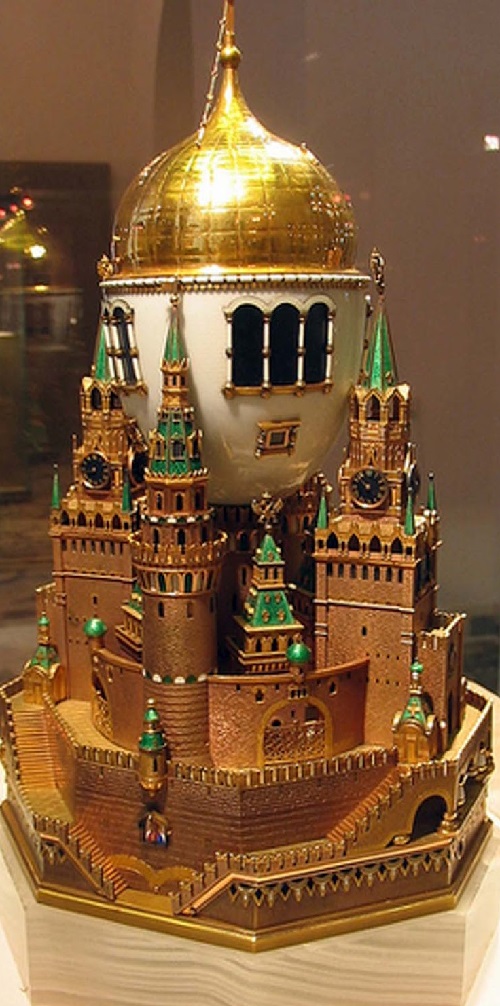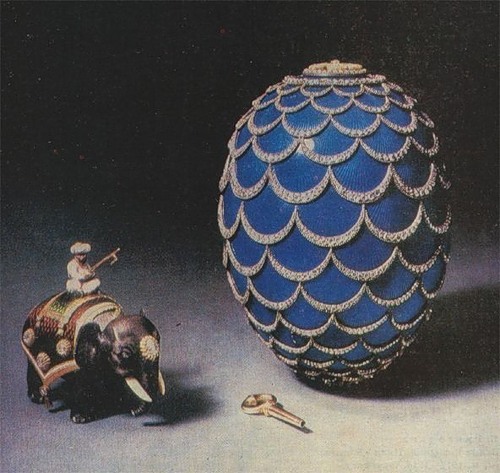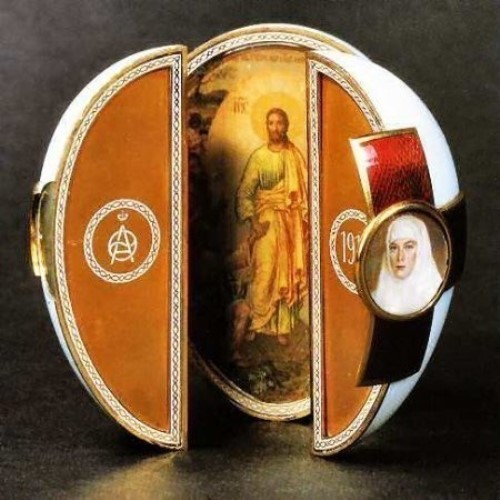Russian jeweler Carl Faberge

“The Moscow Kremlin” (“Cathedral of the Assumption”) – one of the fifty-two imperial Easter eggs made for the Russian imperial family. Created by order of Nicholas II, who presented it to his wife Alexandra Feodorovna on Easter 1906. Stored in the Kremlin Armoury. One of the few eggs that have never left Russia. Russian jeweler Carl Faberge
Russian jeweler Carl Faberge
Born on May 30, 1846 in Saint Petersburg, Karl Gustavovich Faberge was an outstanding Russian jeweler of Baltic German-Danish and French origin. He was the son of the jeweler Gustav Faberge and his Danish wife Charlotte Jungstedt. Although the House of Faberge is famed for its Imperial Easter eggs, it made many more objects ranging from silver tableware to fine jewelry. Faberge’s company became the largest jewellery business in Russia. In addition to its Saint Petersburg head quarters, there were branches in Moscow, Odessa, Kiev and London. The jewellery house produced some 150,000 to 200,000 objects from 1882 until 1917. In 1900 his work represented Russia at the 1900 World’s Fair in Paris. As Karl Faberge was a member of the Jury, the House of Faberge therefore exhibited hors concours (without competing).
Nevertheless, the House received a gold medal and the city’s jewelers recognized Karl Faberge as master. Additionally, Karl Faberge received the most prestigious of French awards, including a title of a Knight of the Legion of Honor. Two of Karl’s sons and his Head Work master were also honored. Commercially, the exposition was a great success and the firm acquired a great many orders and clients. Karl Faberge died at the age of 74, in 1920.
The “Memory of Azov” carved from one piece of bloodstone and is encased in Rococo gold scrolls with diamonds. An intricate miniature of the ship, “Memory of Azov,” rests on top of an aquamarine representing water. The ship is made of gold and platinum with diamond accents.
Great Gatchina Palace built in 1766-1781 in Gatchina, designed by Antonio Rinaldi for the favorite of Catherine II – Count Grigory Orlov. Situated on a hill above the Silver Lake, the palace combines the themes of a medieval castle and a country residence. The interiors of the palace – a sample of Russian classicism of XVIII-XIX centuries. The palace was one of the favorite holiday destinations of the royal family.
The Resurrection of Christ – the jewel egg, one of the Imperial Easter eggs made by Faberge for the Russian imperial family. Created in the period from 1884 to 1894, commissioned by Tsar Alexander III and presented to his wife, Empress Maria Feodorovna. Currently part of the collection fund of Viktor Vekselberg.
“Military Steel” – jewelry egg, one of the fifty-two imperial Easter eggs made by Faberge for the Russian imperial family. Created in 1916 for Tsar Nicholas II and given as a gift at Easter to his wife, the Empress Alexandra Feodorovna. At the moment the egg is in the Armory Museum in Moscow, and remains one of the few Faberge eggs, which never left Russia.
The Rothschild egg – jeweled, enameled decorated egg made under the supervision of the Russian jeweler Peter Carl Faberge in 1902 by the workshop of Michael Perchin, for Beatrice Ephrussi de Rothschild, who presented the egg to Germaine Halphen upon her engagement to Beatrice’s younger brother, Edouard Alphonse James de Rothschild.
Egg with rotating thumbnail (Rhinestone). This jewel egg, one of the fifty-two imperial Easter eggs made by Faberge for the Russian imperial family. It was created in 1896 for the Empress Alexandra Feodorovna. At the moment the egg is a jewel in the collection of Virginia Museum of Fine Arts.
Imperial Easter egg ‘Bud’ by Peter Carl Faberge, 1895. The first egg donated to Alexandra by Emperor. “Surprise” – a rose, a reminder of the homeland of the Empress, famous for its flowers. Imperial Easter egg ‘Bud’, Style – Neoclassicism. Egg colored gold, transparent red and opaque white enamel, diamonds, velvet. Bud of gold, green and yellow opaque enamel. Dimensions – 6.8 cm egg-topped with portrait miniature of Emperor Nicholas II, the year written on a pedestal eggs under the diamond. The egg opens, inside the egg is a yellow rose bud, which, in turn, has two surprises: a miniature model of the imperial crown and ruby egg-shaped pendant hanging in it. Presented by emperor Nicholas II to his wife Empress Alexandra Feodorovna at Easter 1895, now held in the collection of Vekselberg.
‘Clover’ egg. Gold, platinum, diamonds, faceted rose, ruby. Dimensions – 9.8 cm Openwork egg with a hinged lid made of gold skanjat leaf clover, some of them filled with light green enamel transparent window, and some – small diamonds. Placed between the leaves are narrow curved band scored small rubies. The openwork rim eggs – the image of the imperial crown, the date “1902” and the monogram of Empress Alexandra Feodorovna in a frame of clover flowers. Surprise lost. But the museum staff managed to find a unique archival document from which it follows that the inside was fortified precious quatrefoil with 4 thumbnail. Probably on the petals of a surprise were portraits of the king’s daughters (Olga, Tatiana, Maria and Anastasia), so it was a symbol of a happy marriage of Nicholas II and Empress Alexandra Feodorovna, the symbol of the connection of two loving people. Given by Emperor Nicholas II to Empress Alexandra Feodorovna at Easter 1902 . Received from Moscow Jewelry Association in 1927. Kept in the State Kremlin.
Alexander Palace jewelry egg, one of the fifty-two imperial Easter eggs made by Faberge for the Russian imperial family. The egg was created by order of Nicholas II in 1908, who gave it to his wife Alexandra Feodorovna at Easter 1908. Received by the People’s Commissariat of the Monetary Fund in 1927. Stored in the Armory – the Moscow Kremlin State Museum, Inv. No MP-648, Moscow, Russia.
‘Peter the Great’, the work of the imperial court of Carl Faberge in 1903. Made by a master jeweler Michael Perkhin in 1903 at the jewelry company of His Imperial Majesty Nicholas II. Dedicated to the anniversary of St. Petersburg, the 200th anniversary of the founding of the city. Within the model – the Bronze Horseman. 4 thumbnails on the sides with views of St. Petersburg. Rococo style. Gold, diamonds and rubies. Egg “Peter the Great” was donated to Emperor Empress Alexandra Feodorovna at Easter 1903. Stored in the Art Museum of Richmond, Virginia, USA.

‘300 anniversary of the Romanov dynasty’, made at the Imperial court by jeweler Carl Faberge firm in 1913. Master – Henry Vigstrem
‘300 anniversary of the Romanov dynasty’. The egg made to the tercentenary of the Romanov dynasty, decorated with miniature portraits of eighteen representatives of the reigning dynasty. At the top and bottom of the egg-fortified flat diamonds, which are visible through the date “1613” and “1913.” Inside the fortified eggs rotating steel blued globe, which twice put gold trim an image of the Northern Hemisphere: one – colored gold marked the boundaries of the territory of Russia in 1613, on the other – the borders of 1913. Presented by emperor Nicholas II to Empress Alexandra Feodorovna at Easter 1913. The State Kremlin Museum.
‘The Order of St. George’ Etched enamel egg with a trellis lattice of leaves, with small crosses of St. George covered with a transparent enamel. A pearl-draped ribbon embossed the Imperial Order of St. George, executed in black and clear orange enamel. On one side of the Order of the white and red enamel, suspended from the sash. Tilted up using the small button, opening under a miniature portrait of Nicholas II. On the reverse side is placed a silver medal of St. George with the profile of Nicholas II and the inscription on the edge of the ‘E. W. Nicholas II, Emperor of All-Russian” (his Majesty Nicholas II, Emperor of All-Russia). Also hanging ribbon and opening under a thumbnail, this time – Tsarevich Alexei Nikolaevich, on the reverse “For courage, 4th grade’. At the top of the egg – the monogram of the Empress Dowager, made overlaid with silver, surrounded by a wreath of leaves with berries clear green and red enamel with a border of white enamel. Nicholas II ordered the Faberge egg “The Order of St. George” for his mother at the end of 1915, shortly after receiving the award. Stored in the collection of “Forbes” magazine, New York, USA.
‘Laurel tree’, the work of Carl Faberge, 1911. Known as “orange tree” Egg executed in the form of topiary tree with a dense crown of jade leaves with flowers and fruits of precious stones. Besides, with white enamel petals: champagne-colored diamonds, amethyst, citrine and pale ruby. In the foliage hidden key hole and a tiny lever actuation of which raises the round cover on the top of the tree. Then from the inside there is a songbird that flaps its wings, turns its head and sings, opening beak. The tree “grows” out of the gold soil, sprinkled in square tub of white quartz, decorated with gold lattice trellis with heads of flowers. A garland of laurel transparent green enamel with berries of rubies, cabochons, and diamonds. Egg gift to Maria Feodorovna from Nicholas II. Stored in the collection of Vekselberg.
“Lilies of the Valley” – one of the fifty-two imperial Easter eggs made by Faberge for the Russian imperial family. Made in 1898 as a gift for Easter to the last Russian Empress Alexandra Feodorovna, wife of Nicholas II. The egg in the Art Nouveau style, made of translucent pink guilloche enamel, on the golden pedestal with four legs. Lilies attached to the egg, made of green enamel, gold and pearls. Clicking on the side of the top of the pearls puts forward three medallions. The upper medallion depicts Nicholas II in uniform. The left medallion – portrait of Grand Duchess Olga, the right – Tatiana. The top crowned with a crown, medallion decorated with diamond and ruby cabochon.
Russian jeweler Carl Faberge

“Pine cone” Surprise – an elephant with a mahout. Bought for $ 2.8 million by widow of the founder of the corporation, “McDonald’s”

‘Peacock’ egg. Peacock can be removed from the branches. Jeweler – Dorofeyev. Inspired by the famous watch-peacock in the Hermitage

‘The Swan’ opens if the line of cleavage. Surprise – the swan. The Foundation of Edward and Maurice Sandoz, Lausanne, Switzerland

The Red Cross with Triptych enameled Easter egg made under the supervision of Peter Carl Faberge in 1915

’15th Anniversary of the reign’. Miniatures – 7 portraits of family members and 9 scenes of the reign, including the coronation, the opening museums and monuments, the relics of Seraphim of Sarov. Jeweler – Henry Vingstrem

Clover – jewelry egg, one of the fifty-two imperial Easter eggs made by Faberge for the Russian imperial family. 1902

Spring flowers – jewellery factory Carl Faberge, made around 1899 in the workshop of Michael Perkhin

“Kelekh Hen” Repeats the iconography of the first emperor “Chicken” eggs. First owner – Barbara Kelch-Bazanova. collection of Vekselberg
liveinternet.ru/users/neznakomka-hhhh





















